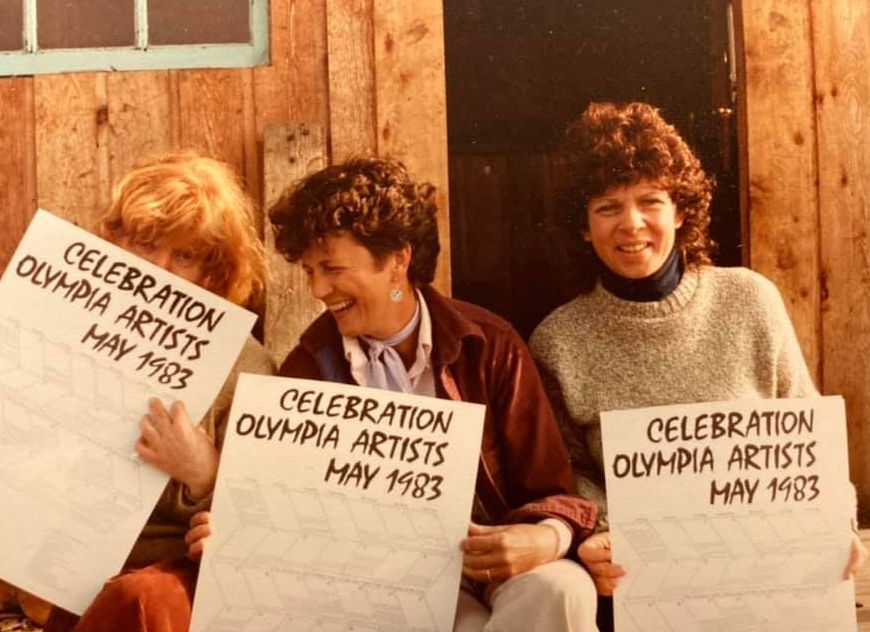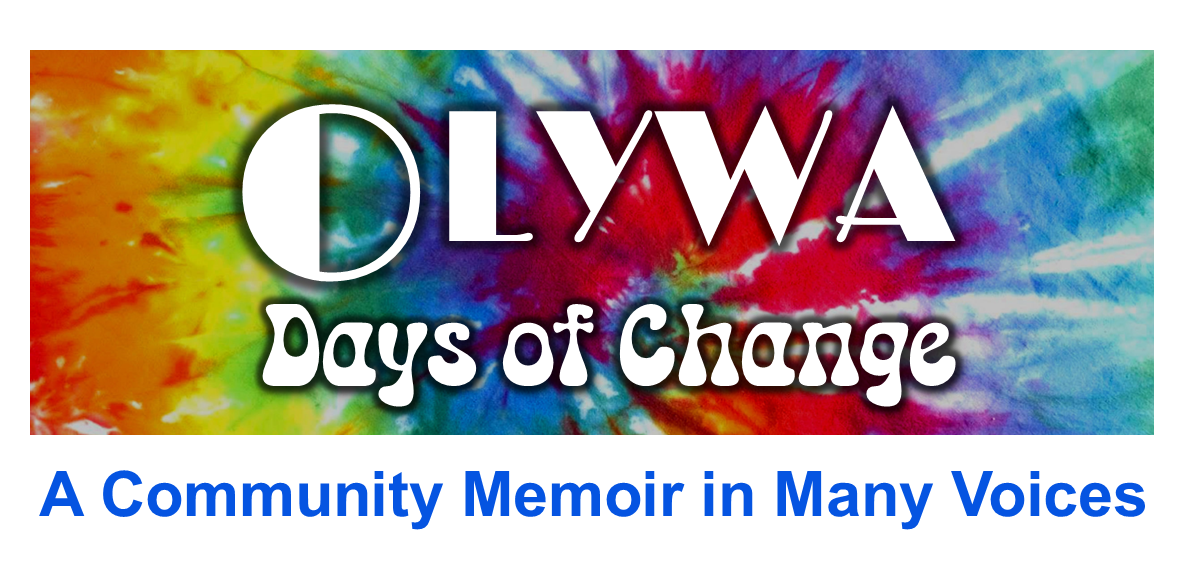ARTS
Celebration of Olympia Artists – May 1983
By Llyn De Danaan
“I remember sitting in the Rainbow drinking wine
and wondering why artists don’t get the attention athletes get.
And since the world will be watching women run here*
why not invite people into studios and galleries.”
Marilyn Frasca, visual artist
*Reference to the first USA Olympics Marathon Trials to be held the following year, May of 1984, in Olympia. The marathon was a heart-thumping event for the women of Olympia . . . and Lily Tomlin performed that night, just to keep everyone riding the wave.
Since the late 1960s, everything had been up for grabs, questioned, reenvisioned, and reinvented. Visual artists, especially women, questioned the power and money that drove gallery shows and collections, their own exclusion from the lists of the great, and the general elitist and exclusionary practices of the patriarchal art world.
New forms flourished: installations; murals as radical forces for decolonization in the California Chicano communities (see Judy Baca mural program in 1974 in Los Angeles for example); performance art, especially in service of social justice and to encourage conversations about women’s sexuality and shatter the male gaze. Rules were broken. Audiences were shocked. In the 70s, Judy Chicago, one of the leading figures of the feminist art movement, collaborated with hundreds of other women to create The Dinner Party. It opened in the San Francisco Museum of Modern Art in 1979. Olympia artists were aware of these national efforts to create a place for women and diverse communities in the visual arts. They were inspired.

There were many empty spaces in downtown Olympia in the 1970s and artists rented them for a pittance. Many of these artists had been or were students at The Evergreen State College. There was limited studio space at the college. Faculty cobbled together facilities in the Lab Building, for example. The Arts Annex, with new space built for studios and a ceramics lab, was not built until 1987.
The arts faculty had a rough time meeting the requirements of teaching at Evergreen full-time, writing lengthy evaluations, yet doing any of their own work. Some of them, too, rented studio space. One faculty member, Paul Sparks, built a studio in his backyard. Susan Christian had a studio in a Water Street building near the corner at Fourth Avenue. Other artists, including glass artists Cappy Thompson and Bonnie Moonchild, silk screen artist Nancy Sigafoos, and painter Susie Jones converted buildings or found downtown spaces.
Others offered exhibition space, including Shannon Osbourne, whose Smithfield Café superseded Carolyn Street LaFond’s Café Intermezzo. Childhood’s End Gallery was another fine place to show work. Both were on that block of Fourth Avenue that saw a lot of action during the period. Laura May Booker ran the fabulous Rainbow Restaurant where you could catch jazz greats like Joanne Brackeen, and see all of your friends. Susan Christian and Russell Culbertson had the Artemis Gallery in that block. Though it was open only a few months, it is remembered for Susan’s display of Turkish rugs, one of which was purchased by Laura May and hung in the Rainbow. Artemis later became the home of The Northwest Center for Visual Anthropology.
An art scene of sorts was a-birthing in the downtown. Many visual artists in town were interested in collaborative and inclusive work and hoped for more venues in which to showcase their own pieces.
In 1983, Lynn Patterson (aka LLyn De Danaan, photographer and cultural anthropologist), Marilyn Frasca (visual artist and Evergreen faculty), Shannon Osborne (owner of Smithfield Café), Mary Fitzgerald (photographer), Candy Street, Cappy Thompson (glass artist) and Carolyn McIntyre (the founder of Radiance) created an arts feast to demonstrate that artists were at the core of a new Olympia. They organized a month-long “Celebration of Olympia Artists” and, in the spirit of inclusivity and collaboration, invited the community to submit information about their own events and to participate in a variety of shows.
The organizers were a savvy group of women. They obtained the endorsements of Friends of the Evergreen Gallery, Lynn Schrader (development director for the Washington Center for the Performing Arts), the Olympia Downtown Association, and R/UDAT (Regional/Urban Design Assistance Team, a group formed to rejuvenate downtown Olympia). R/UDAT called for such changes as the boardwalk on Percival Landing, opening the Washington Center, and promoting the Music in the Park summer series.
Events were published on a large poster-sized calendar by the founding/organizing group in April. Nancy Sigafoos designed and printed a bright, welcoming t-shirt for the event. The group managed to obtain great local news coverage. Several solid articles about the event were published, including a couple of feature interviews.
Morris Piha donated space in the empty Miller’s department store building on Capitol Way and Legion Avenue. The space was used to hang citizens’ art, with a special section for children’s art. The people’s gallery was open several hours and several days each week for the entire month. Thirty-three pieces were selected for the Miller’s grown-up juried exhibit. These included paintings, drawings, photography, and pottery. The show opened at 6 p.m. on Sunday, May 1 and was hosted by Lori Salzer and Sally Cloninger, both dressed in tuxes and serving libations. Eight-year-old Adam Soule was the winner of the children’s show (in 2022, he’s a volcanologist with University of Rhode Island).
The shows in the Miller’s building were judged by Lynn Patterson, Jess Spielholtz (a public health doctor, activist, and supporter of The Evergreen State College), and Dick Clifton (exhibit designer and then Chief of Interpretive Services for the Washington State Parks and Recreation Commission). Clifton designed and developed some of Washington’s best interpretive centers, among them the Lewis and Clark Center at Cape Disappointment, and Fort Columbia near Chinook, Washington.
There were studio tours with maps available at the Smithfield Café. A guided tour was offered on May 22. During the final weekend, Olympians were invited to watch artists at work in Childhood’s End Gallery or in various downtown studios. There was also a benefit dance for the band Obrador. It was a fabulous month and a successful precursor to what became Arts Walk.
* * *
On a personal note: I loved collaborating and producing, experimenting, and playing. In the spring of 1984, Sally Cloninger (Evergreen faculty and filmmaker) and I produced side-by-side shows in Evergreen Gallery Four. Hers was a video installation. Mine was multi-media featuring portraits of friends whom I dressed and photographed in staged scenes from my fantasy films. I also introduced my alter ego, Agnes Sorrell. She was a world traveler. Sally Cloninger made photos of her as she posed in front of a China Clipper. Agnes was a composite of all the white women in Asia films I had consumed in childhood. This was long before we had an adequate framework for a critique of the colonial enterprise, but we were trying. Cloninger and I took our fantasies to the American Embassy in Kuala Lumpur one Halloween, dressed as Martin and Osa Johnson (adventurers and documentary filmmakers). Was it performance art? Another comment on the images presented to white middle-class American children in the form of films and the book, I Married Adventure? We won the costume contest.
Cloninger’s show, Jalan-Jalan Ke Rumah Saya (Going to My House), included a video plus her still photographs. The show was visited by our friend Ismael Zain, Cloninger’s Fulbright guide from her time in Kuala Lumpur. The late Zain has been called the father of Malaysia’s modern art movement and he is celebrated for early work in digital image making. He honored Cloninger by conducting a puja (a worship ritual of celebration) in her gallery space.
Perhaps our most underappreciated performance piece was the re-creation of an experiment conducted at the Yerkes Institute of Primatology. We set up monitors on an invited “gorilla” in the CAB building at The Evergreen State College so that community members could see for themselves what programs the gorilla chose to watch between 10 a.m. and 2 p.m. The Evergreen gorilla ordered tapes from Videoland and asked to see one of Cloninger’s films. He/she watched all of the film Gandhi, two versions of King Kong, The King of Hearts, Double Indemnity, and The Twenty Minute Workout. The gorilla enjoyed Samson and Delilah and became over-excited when Victor Mature appeared on the screen, throwing a chair at the monitor when Delilah cut his hair. I have our copious observation notes. Very thorough. During this same period, Cloninger and I rented the space that had been the Artemis Gallery and established a home base for the Northwest Center for Visual Anthropology. Cloninger and a team of students projected 16 millimeter loops against the window. Sound accompanied the images, heard and seen by passersby. The loops comprised a piece called Recordings from Real Life.
We encourage readers to use the form below to make comments and suggestions. Disclaimer
